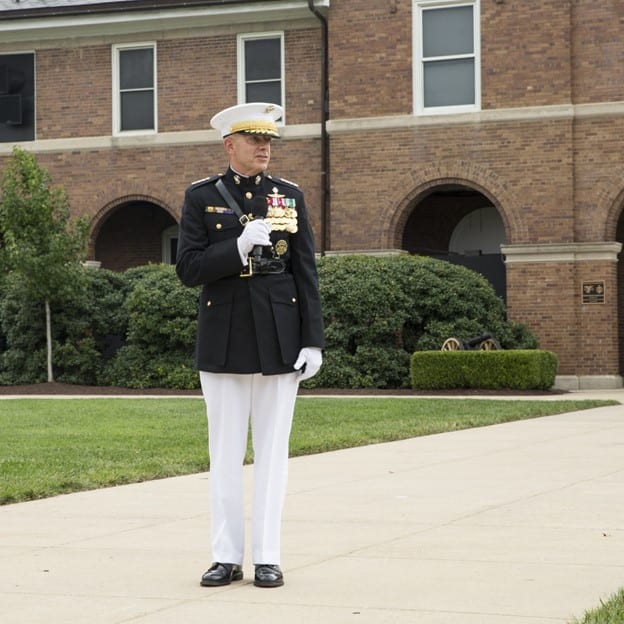Marine Corps Commandant wants Marines to trust technology

Commandant of the Marine Corps Gen. David Berger said cooperation, innovation and trust are keys to future success for the sea services.
“Going forward in a great power competition, no single service is going to keep our advantage,” said Berger, speaking at the National Defense Industrial Association’s virtual Expeditionary Warfare Symposium, being held Feb. 2-3. “Only by the Marine Corps and the Navy working together as a naval force will we be able to maintain our margin. Add the innovative technologies, that’s how you get an asymmetric advantage against a near peer or a peer adversary.”
Berger said despite the arrival of a new administration, the premise or foundation of the current National Defense Strategy — to discourage malignant military countries that want to challenge the international security environment — is solid.
In his view, the future operating environment is going to be characterized by a maturing and more proliferating precision strike regime in a maritime region. That’s going to require the Marine Corps, as the Joint Force’s stand-in force, to be forward deployed and distributed.
“If a conflict comes, then I think that our near peer competitors are not going to allow us to build up and set the theater and take a couple of months to do that,” said Berger. “Where you start from in a great power competition is where you were the day before. They’re not going to allow a flow of forces, because the know how that’s going to work. So, our forward standing in forces have to be ready immediately respond to a crisis. If we don’t start posturing and strengthening the naval services today, we’re going to fall behind. And that’s not going to happen.”
Altering our trajectory
Innovation is being driven by the threat, and by available resources.
“All of us in the Navy and Marine Corps recognize the same challenges in the emerging operating environment that’s before us. There is an urgent need for innovation and rapid change,” said Berger. “We are being driven by a pacing threat. We have to do it with no additional funding or resources.”
Berger expressed confidence in the force structure changes as set out in the Marine Corps Force Design 2030 effort, which examines the right mix of hardware, but also unmanned systems, artificial intelligence and sophisticated and survivable networks. “That’s how our force in readiness will alter our trajectory to create an advantage for the fleets and the overall force.”
“That force design — the major overhaul of the Marine Corps — provides the nation a force that’s capable of denying key maritime terrain to an adversary because of our forward presence, and its going to force our competitors to think twice before challenging our interests,” Berger said. “That is the essence of deterrence.”
To achieve that, Berger said the service needs to reset is systems and equipment.
“The Marine Corps has to modernize, not just our equipment, but we’ve got to modernize our training, our forces and our equipment. I am convinced that yesterday’s force will not compete effectively with tomorrow’s adversary, especially in the maritime gray zone. Putting it bluntly, just making our legacy platforms better, or just making more of them available will not allow us to maintain an advantage against either China or Russia in the maritime domain.”
Berger said that Marines operate in an expeditionary distributed operational environment, and operating in that environment with repurposed kit or repurposed equipment would be “irresponsible, and it’s not good enough. We can’t continue to invest in programs that don’t support force design and where we’re going.”
This is where Berger said he needs help from industry to “creatively find the solutions that will get us there. I’m not just talking about a better version of what we’ve got, but how can we disrupt; how can we deter an adversary — especially on the high end. A new and improved version of the light armored vehicle is not going to solve the problem. We have to look at building totally new capabilities, and use technologies in new ways to solve these complex future problems,” he said. “We have to outthink and outmaneuver a pretty capable adversary.”
Confidence and trust
“I’m a believer in manned and unmanned teaming,” Berger said. “That’s where we’re headed. But technology is not going to replace the individual Marine, of course. It will enable the Marine to be more lethal.”
Berger said it’s a matter of confidence and trust. In some instances, Berger said we don’t trust the machines.
“There are systems that offer fully automated sensor to shooter targeting, but we don’t trust the data,” he said. “We still ensure there is human intervention, which adds more time and opportunities for mistakes.”
Berger talked about emergency medical evacuations, which are today conducted using manned helicopters to get a wounded Marine from the battle front to a medical facility safely in the rear. He alluded to expensive manned helicopters, such as the CH-53K helicopter, which may be too big to risk in a hostile environment, but there are unmanned options, like the unmanned K-Max helicopter, that have been demonstrated to carry patients to safety.
“In the same way a squad leader has to learn to trust his or her Marines, a squad leader is going to have to learn to trust the machines.”